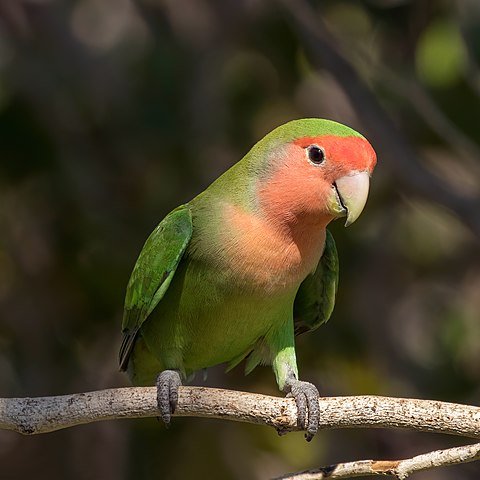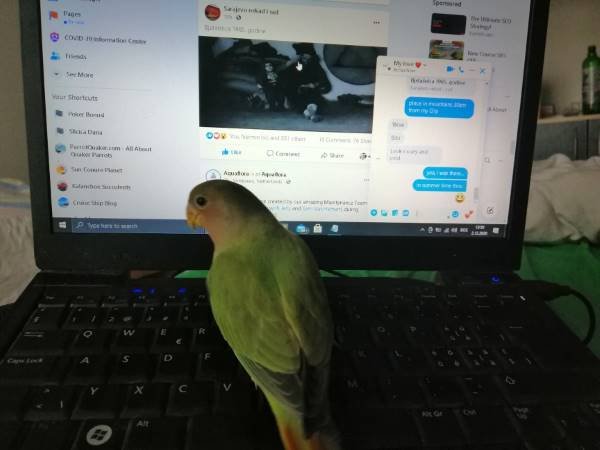The word lovebird brings beautiful and petite parrots to mind that have peachy faces. There are many species of lovebirds, but the peach-faced lovebirds are hands down the most famed across the globe.
Peach-faced lovebirds are also the most petted of all the lovebirds’ species. This can be accredited to their soft demeanor and ease of care. But they have more to them than just pretty peach faces. Let’s know all about peach-faced lovebirds that are also fondly called the Rosy-faced Lovebirds.
Peach-faced Lovebird Habitat
Native to the African continent, peach-faced lovebirds can be found inhabiting the open and dry regions of South Africa. Their range extends from south-western Angola to Namibia to the valley of Orange River. They can be spotted in large flocks of around 50 birds in woodlands, mountainous, and semi-desert regions.
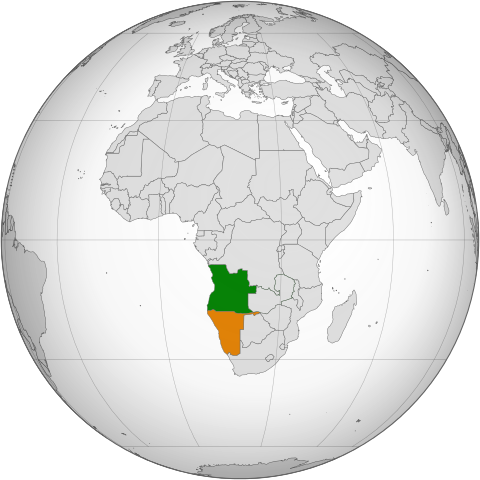
Peach-faced lovebirds happen to be cavity dwellers and thus, make their nests in rocks, trees, and shrubs in the wild. And while in the urban settlements, they very well look for building crevices and cacti as a replacement.
Peach-faced Lovebird Physical Taxonomy
The physical taxonomy of this species of the lovebird family has earned him the status of being the perfect bird for the beginners. With small size and beautiful colors, they are usually the preferred choice of many novice bird keepers.
Peach-faced Lovebird Size
A pretty small-sized parrot, peach-faced lovebird has an average length of 6.5 inches measured from head to tail. The male peach-faces tend to be a bit longer at around 7 inches against their female counterparts that stand at around 6 inches. The wingspan of peach-faced lovebirds averages a mere 4 inches.
Peach-faced Lovebird Weight
Coming to the weight of the peach-faced lovebirds, their petiteness makes them lightweight and thus, easy to manage. Their weight can range anywhere between 46 to 63 grams depending on their sex, diet, and length. The males peach-faces tend to be a bit heavier than the female birds.
Peach-faced Lovebird Colors and Markings
Scientifically known as Agapornis Roseicollis, the peach-faced lovebird genus has two subspecies including the nominate one. Thus, their color and markings vary accordingly:
- Agapornis Roseicollis Roseicollis– The nominate race of the peach-faced lovebirds’ genus, A.r. Roseicollis has an overall green plumage and a blue rump. The peach color of the face and throat makes them stand out easily from the lovebird genus. This color is darkest on the forehead and over the eye but gets lighter in the shade as it moves down the throat. The iris is brown with a narrow white ring surrounding the eyes; the bill is horn-colored, and the feet and legs are gray. The tail is green with the side feathers having black edges. This subspecies is dominant in Botswana, Namibia, and South Africa.
- Agapornis Roseicollis Catumbella– Found in Angola region, A.r. Catumbella species is almost identical to the nominate race. The only difference that sets them apart is the relatively deeper shade of peach color on the forehead and cheeks. When compared to A. r. Roseicollis, the color is almost a shade of darker red than peach.
Peach-faced Lovebird Color Mutations
With the growing love for the rosy-faced lovebirds, the demand for a broad color palette also spiraled quickly. This has made them one of the most favored parrot species among breeders for color mutation. One can find a wide range of color mutations of peach-faced lovebirds like white-faced, dutch blues, orange-faced, mauves, pied, lutinos, violets, turquoise, cinnamon, opaline among many others.
And the list is ever-increasing as the breeders keep on adding a new color mutation now and then to meet peach-faced lovebirds’ aficionados. It is said that there are almost a hundred thousand colorful peach-faces.
Peach-faced Lovebirds Lifespan
The lifespan of peach-faced lovebirds varies with their habitat. And the difference is noticeably much in their lifespan in the wild and captivity.
Peach-faced Lovebirds Lifespan in the Wild
When in the wild, the peach-faces have been recorded to live for around 12 to 15 years. And this is much less than what they live for in captivity. The shorter lifespan is usually attributed to lack of balanced diet, inaccessibility to water sources, dangers from the predators, and lastly, lack of appropriate care.
Peach-faced Lovebirds Lifespan in Captivity
A peach-faced lovebird’s life in captivity has a much better quality that lends him far more years than in the wild.
How long do Peach-faces live for?
Surprisingly, peach-faces can easily live for around 15 to 25 years when they are indoors. However, one such pet lovebird holds a world record for living for more than 34 years in captivity. This remarkable feat has been attributed to a well-balanced diet, adequate medical care, and loads of love from the lovebirds’ owner.
Peach-faced Lovebirds Diet
The most important aspect of any living being is his diet. It determines his quality and quantity of life. And peach-faces are no exception. If fed a diet covering the required nutrient profile, peach-faces make a good companion for almost half of anybody’s lifespan himself.
What does Peach-faced Like to Eat?
While in the wild, peach-faces feed on a variety of foods like berries, grains, seeds, and insects. It may vary with surroundings.
Fresh Fruits and Vegetables
Fresh fruits and vegetables are a great source of adding optimum nutrition to a peach-faced diet profile. Such kinds of foods are wholesome, easily digestible, and the healthiest. When it comes to fruits, feed them fresh produce like strawberries, apples, mangoes, pineapple, grapes, et al.
And from the vegetable platter, add a lot of leafy greens like spinach, collard greens, kale, beet greens to their diet. Add a few slices of vegetables like winter squash, pumpkin, or carrots to add a little Vitamin A to their bodies.
Tip- Do not overdo with fruits loaded with natural sugars like pineapple. And do not forget to remove the seeds of the fruits before serving. Also, do not serve them pitted fruits like avocado as they are poisonous for them.
Pellets
Pellets are vital to keeping peach-faces healthy as they tend to have every essential nutrient needed by these little birds. If any nutrient is amiss from the bird’s daily dietary requirements, pellets make sure to cover up for the loss. It is recommended that pellets must form around 50-70 percent of the peach-faced lovebird’s daily feed. And just about a little of these is enough for them.
Tip- For the best results, always look for the dosage needs mentioned on the brand package you use. And make sure to choose only high-quality reputed pellet brands as they are free of artificial additives.
Seeds
Just like in the wild, peach-faces love to have little seeds while in captivity too. Quinoa, chia, safflower, sunflower, millet, or buckwheat are all great options. Alternate between them for variety or make a varied mix of 2-3 of them to keep the bird interested. Keep swapping the variety in the seed mix too. Soak them for 4-5 hours before serving as this makes it easier for the bird to chew apart from neutralizing the excess fat content in them.
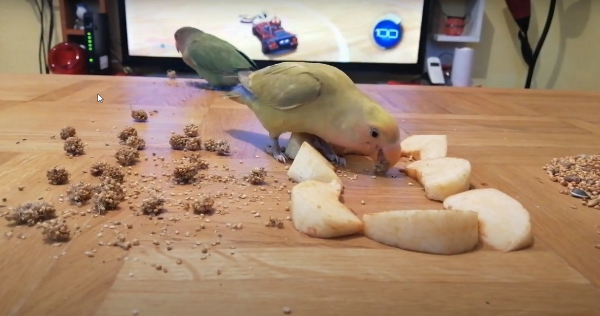
Tip- Seeds must be fed in very small quantities to peach-faces as they are high in fat content posing a threat of fat accumulation in the birds. Also, it is always recommended to serve a homemade seed mix as the market -bought formulas are loaded with additional fat and unhealthy preservatives.
Fresh Water
A must for survival is the freshwater. Offering freshwater of drinkable quality at all times to peach-faces is necessary for more than one reason. It prevents dehydration, regulates their body temperature along with transporting all the nutrients from food to all the organs. Use only filtered water or the one that has been cooled after bringing to the boiling point.
Tip- Always keep a backup bowl in the cage, especially for the hotter days. Also, do not forget to change the water every few hours to stop the growth of germs.
Peach-faced Lovebirds Care
Care ranks next to the diet to increase the longevity of the peach-faces. Following a simple care regime that covers the basic needs of the bird other than the diet goes a long way in making him live longer than in the wild:
Provide a large cage to the bird with a size of at least 18X18X18 inches. This would give the bird ample space to play and flex his wings for short flights.
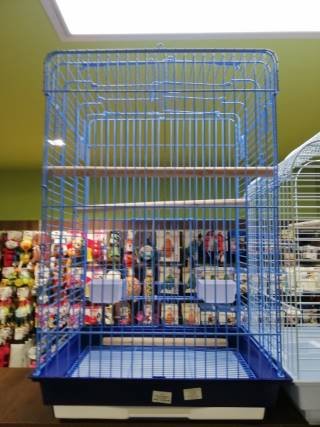
Add all the necessary feeders for food and water to the cage for easy access to his daily diet.
Add around 5 to 6 perches of varied sizes and thickness to make the bird feel closest to his habitat. The varying thickness also helps the bird to firm his grip and maintain the feet nail length.
To keep the bird entertained, adding ample toys is a must. Since peach-faces are quite an active species, they are easily struck by stress and depression if they are left with nothing to do all the long.
Lastly, it is important to keep the bird’s surroundings clean. Clean the cage at least fortnightly to avoid the breeding of bacteria. Also, take the bird to the vet regularly for a general checkup.
Peach-faced Lovebirds Gender Differences
Peach-faced lovebirds are monomorphic which makes it difficult to sex the bird visually. All the colors and markings of the plumage are almost identical. But the experts still claim to sex them aptly just by random physical observations like:
- Judging the distance between the pelvic bones of the bird is quite a popular way of sexing the bird. If that distance is between 1 to 3 mm, the peach-faced is said to be male. And for females, the range of this distance is between 6 to 8 mm.
- Another popular visual sexing is to distinguish them from their behavior. Female peach-faces are famed for their aggression and loudness when compared to their male counterparts.
- Next in line is the obsession of females for having a nest of her own. Whether female peach-faces are a part of an established pair or not, they are most likely to start building the nest as soon as the breeding season kicks in. And they also have a very unique way of collecting the nesting material. Peach-faces are famed for hiding the nest material inside their rumps and bringing it to the nesting site for construction.
How do you tell the difference between a male and female peach-faced lovebirds?
The best way to distinguish a male peach-faced lovebird from the female one is by DNA sexing. It also happens to be the most accurate one too. It is by far the easiest method and also, a non-invasive one. The vet simply takes the sample of the blood after clipping the bird’s toenail. The sample is then tested in the laboratory. It takes a few days for the reports mentioning the gender of the bird.
Though it happens to be the easiest method, there is an alternative to collecting the blood sample. All one needs is some of his peach-faced feathers from the abdominal region and sent them to the laboratory for testing. This way, there is no need to take the bird even to the vet. But care needs to be taken while plucking the feathers as the wrong way of doing it might be the cause of infection for the bird.
Peach-faced Lovebirds Talking Ability
Peach-faced lovebirds aren’t known to be great talkers. Unlike other parrot species like African Grey or Quaker Parrots, peach-faces can hardly mimic a word or two and that’s too, in a very unclear manner. Almost all of the peach-faced lovebird pets do not utter a word all their lives. Hence they prefer sticking to their ‘bird language’. That said many peach-faces have been known to excel at mimicking sounds and whistling songs they hear from their surroundings.
Also, since all the parrot species have a voice box resembling humans, they can be taught to talk if trained well. And this holds for peach-faces too. There have been instances of peach-faces learning more than just a word or two. But to achieve that feat, the pet parent needs a good training technique and a lot of patience.
Are Peach-faced Lovebirds Loud?
Peach-faced lovebirds aren’t loud at all. Apart from the morning and evening contact calls, chirping is the sound they make all day. And with that small a size, even if they tend to shout at the top of their lungs, their volume is very well outside the definition of ‘noise’. Hence, they have been labeled as a quiet bird species and a preferred pet parrot choice for apartment dwellers.
Do Lovebirds like to be held?
Lovebirds are cuddly and love sharing a few cuddles with their pet parents now and then. Thus, they like to be held by their favorite human. But it all comes with a condition. Like any other pet member of the family, one needs to form a strong bond first with his peach-face to get closer to the bird. Once the bird’s trust is gained, all the peach-face wants are some cuddles and kisses from his ‘flock member’.
Peach-faced Lovebird Breeding
Peach-faced lovebirds attain sexual maturity at an average age of 1 year. The female peach-faced normally lays 3 to 5 eggs in a clutch a week after mating. The eggs are hatched after around 21 days of incubation. Both the male and female peach-faces take the responsibility of feeding and taking care of the chicks until they turn a month old. The peach-faced baby leaves the nest after about 6 to 8 weeks or so.
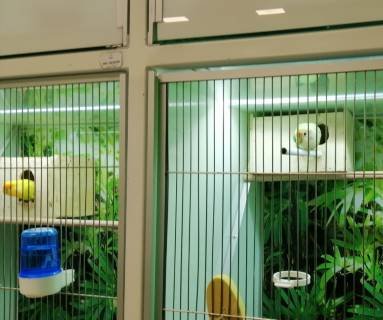
Are Lovebirds nippy?
Peach-faced lovebirds are little infamous for being nippy, especially with the younger members of the family. This is because they take a little longer to tame. If the younger kids in the house are let close to them while they’re still learning to unlearn the biting, these birds may nip them pretty hard. However, they are easily manageable by the older clan of the family. Also, once they get tamed, there is hardly any nipping.
Peach-faced Lovebird Price
Peach-faced lovebirds are one of the most widely adopted pet parrot species from the lovebird genus. This makes them extremely non-premium. One can easily have the original green plumaged peach-face for as low as $25 at the nearest pet store. But for the rarer mutations like lutino, it would need around $230 to gain them as companions.
Additionally, the prices of the peach-faces also vary with varying factors like geographical region of the adoptive pet parent, the fact that the bird is hand-raised or parent-raised, the demand in the local region, et al.
Summing Up
Peach-faced lovebirds are quite popular across the globe for their playful and social nature. They have also been proven intelligent with the ease of cracking the tricks played on them and working out the ways to unlock their cage locks. And with the lifespan of averaging at around 20 years, they have gained an edge over the other short-lived pet parrot species. All one needs to earn a loyal companion in them is to love and care for them unconditionally.
Featured Photo Credit:
Charles J Sharp / CC BY-SA

